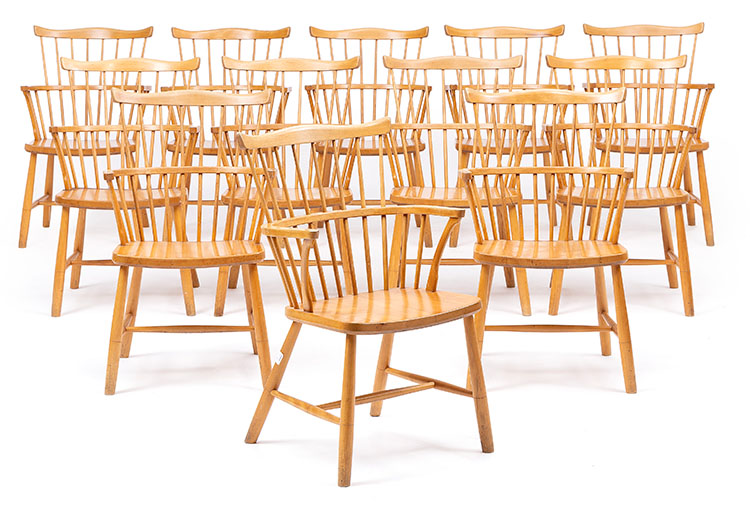Items for sale
Børge Mogensen
-
 2502/835Aarhus
2502/835AarhusBørge Mogensen: Two-seater sofa with oak legs, upholstered with natural leather. Fredercia Furniture. L. 148 cm.
Selling
Estimate :
12,000–15,000 DKK Next bid: Your bid:
-
 2502/846Lyngby
2502/846LyngbyBørge Mogensen: Oak bookcase with removable shelves, later mounted base. H. 159 cm. W. 122 cm. D. 26 cm.
Selling
Estimate :
6,000 DKK Next bid: Your bid:
-
 2502/850Lyngby
2502/850LyngbyBørge Mogensen: Easy chair and wingback chair with mahogany legs. Upholstered with significantly patinated, brown leather. (2)
Selling
Estimate :
8,000–10,000 DKK Next bid: Your bid:
-
 2502/897Lyngby
2502/897LyngbyBørge Mogensen: “Øresund”. An oak dresser, mounted on later, unoriginal runner legs with black metal stretchers.
Selling
Estimate :
8,000–10,000 DKK Next bid: Your bid:
Hans J. Wegner
-
 2502/500Aarhus
2502/500AarhusHans J. Wegner: “Papa Bear”. A pair of teak and oak wingback easy chairs with a matching stool. (3)
Selling
Estimate :
125,000–150,000 DKK Next bid:
-
 2502/549Lyngby
2502/549LyngbyHans J. Wegner: “Airport Chair”. A set of six chairs with steel frame. Seat and back upholstered with black skai. (6)
Selling
Estimate :
8,000–10,000 DKK Next bid:
-
 2502/566Aarhus
2502/566AarhusHans J. Wegner: "Ry 20". A teak sideboard, bottom with six drawers, top with two sliding doors. H. 180. W. 180. D. 52 cm.
Selling
Estimate :
25,000 DKK Next bid: Your bid:
-
 2502/742Aarhus
2502/742AarhusHans J. Wegner: "W1". A set of four oak chairs, upholstered in seats with green checquered fabric. (4)
Selling
Estimate :
8,000 DKK Next bid: Your bid:
Poul Kjærholm
-
 2502/509Aarhus
2502/509AarhusPoul Kjærholm: "PK 0". Black lacquered wooden chair. Manufactured by Fritz Hansen. Plaquette marked no. 252.
Selling
Estimate :
25,000–30,000 DKK Next bid: Your bid:
-
 2503/603Lyngby
2503/603LyngbyPoul Kjærholm: "PK 54". Dining table with cube shaped frame of steel. Circular top of marble.
Selling
Estimate :
30,000 DKK Next bid:
-
 2503/716Lyngby
2503/716LyngbyPoul Kjærholm: “Academy table”. Work table with steel frame. Loose black-lacquered wood top.
Selling
Estimate :
6,000–8,000 DKK Next bid: Your bid:
-
 2503/853Lyngby
2503/853LyngbyPoul Kjærholm: A black lacquered wood drawer section for the "Professor table". H. 9 cm. L. 85 cm. W. 40 cm.
Selling
Estimate :
6,000 DKK Next bid:
Kaare Klint
-
 2503/543Lyngby
2503/543LyngbyKaare Klint: "Games table for a lady". Mahogany set consisting of a table and matching set of four chairs. (5)
Selling
Estimate :
80,000–100,000 DKK Next bid:
-
 2503/567Lyngby
2503/567LyngbyKaare Klint: Circular mahogany coffee table with slightly raised edge and an underlying shelf. H. 52 cm. Diam. 100 cm.
Selling
Estimate :
10,000–12,000 DKK Next bid:
-
 2503/746Lyngby
2503/746LyngbyKaare Klint: An ashwood coffee table with rosewood "shoes". Top with raised edge and underlying shelf.
Selling
Estimate :
6,000–8,000 DKK Next bid:
-
 2503/865Lyngby
2503/865LyngbyKaare Klint: A pair of mahogany floor lamps. Pleated acrylic shade. H. 162 cm. (2)
Selling
Estimate :
6,000–8,000 DKK Next bid:

























